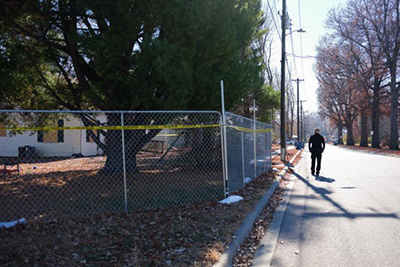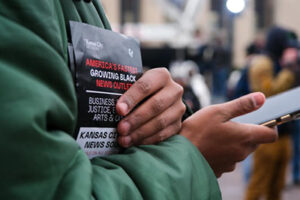
Story by Annie Gowen

KANSAS CITY, MO. — The minister on the TikToK video was visibly upset, warning that a “serial killer” was targeting young women in a drug-ridden industrial area in Kansas City where residents believe a number of women have disappeared in recent months.
“We got three young ladies that are missing, ain’t nobody saying a word,” Tony Caldwell said on the video, with emotion. “What is the problem? Why can’t we get some cooperation? Where are our community leaders? Where’s our activists? Where’s our public officials? Where’s our police department. C’mon now!”
Caldwell’s stark warning about the dangers along Prospect Avenue — posted by the Kansas City Defender, a news site covering the Black community — quickly went viral in late September, garnering nearly 700,000 hits and inspiring the spread of further warnings on Facebook. Then the Kansas City Police Department moved swiftly to rebut the rumors, calling the allegations “completely unfounded.”
The tragedy that came to light two weeks later has roiled the metro area and widened the gulf of distrust between the Black community, which has long felt ignored and dismissed by law enforcement, and the Kansas City Police Department which has been under fire for recent killings of unarmed Black men, racist treatment of Black officers within its own ranks and the city’s rising homicide rate.

In the early hours of Oct. 7, residents on a leafy street in Excelsior Springs, a bedroom community north of the city, were awakened by the sound of knocking and the faint cry: “Help me.” A grandmother opened her door and found an emaciated young Black woman, wearing only a latex bondage dress and a homemade metal collar and padlock around her neck.
The woman, 22, told neighbors she had escaped from a house up the hill where she had been held against her will for nearly a month by a man who picked her up in early September from Prospect Avenue. He had brought her home, locked her in the basement and repeatedly whipped and raped her, she said.
The grandmother brought the woman into her still-darkened living room. When Lt. Ryan Dowdy of the Excelsior Springs Police arrived on the scene and knelt down beside the woman, he saw that she was still shaking with terror, convinced her captor would hunt her down and kill her.
And there was more.
“He killed two of my friends,” she told him.
Caldwell, a minister, and community activist said he began to hear rumblings over the summer about women going missing from a particularly desolate stretch of Prospect Avenue.
“There were so many reports I started getting concerned,” he said. But when he went to the police station to raise the matter, Caldwell said he was told, “‘Well, give it a couple days. You know how those type of people is. They might pop up and they might not.’ At that point I thought we might as well do this for ourselves.”

In late September, Ryan Sorrell, the executive editor, and founder of the Defender, decided Caldwell’s concerns were serious enough to warrant a wider audience in the interest of public safety. He posted the TikTok video with the caveat: “Please know we take these matters seriously and only want to report facts and not fearmonger. However, given the very serious nature of the matter, we believe it is critical to report this.”
For many, the case has raised the specter of a serial killer who terrorized the same area in Kansas City in 2004, a Black man named Terry Blair who strangled at least six women, leaving them for dead in various dark stretches in and around Prospect Avenue. Blair was later sentenced to life in prison for six murders, although authorities believe there were more victims.
“That’s why Black people were so concerned, because this had happened before and they didn’t listen to us then,” said Sorrell said. “That’s why it spread so quickly in the community.”
A spokesman for the Kansas City Police Department, Jacob Becchina, said in an email that at the time Caldwell began to raise questions, the agency did not have any official reports of Black women missing from Prospect Avenue, nor did they have any cases of murdered women, as Caldwell had claimed. A 67-year-old woman had been shot to death within that time frame, Becchina said, but she was believed to be a victim caught in a crossfire.
The authorities’ swift denunciation of the Defender’s post, Sorrell said, “in essence silenced us because then every single news outlet in the city just also parroted verbatim what the police department said.”

Caldwell and other activists said that police often say it is difficult for them to file official missing persons reports because many living in the street go by nicknames, are homeless or have no fixed address. And many in the community avoid contact with the police department altogether, given the long history of troubled race relations in the city.
This year alone, a KCPD detective who shot a Black man backing into his own driveway was sentenced to six years in prison after a 2021 manslaughter conviction. The department paid $5 million to the family of an unarmed Black man shot by police in 2019. And the Justice Department launched a civil rights investigation into the department’s hiring practices after a Kansas City Star investigation revealed endemic racism and abuse within its ranks.
“It’s a systemic issue, and you have people in there who are there for the wrong reasons,” said David Finnell, an Air Force veteran and patient account representative at an area hospital whose family had been trying to locate his missing stepsister, Sirrena Truitt, since June. She had lived along Prospect Avenue, he said, and was one of the women who inspired Caldwell’s video.

Finnell and local activists in the city have said that this case again underlines the tendency for law enforcement authorities and the news media to prioritize cases of missing White women and children over people of color. More than 250,000 women went missing in the United States last year, with more than a third Black women and girls, according to the National Crime Information Center.
Finnell and other family members — to little avail — had been pushing the Kansas City police for months to create an official missing person report and begin investigating Truitt’s disappearance after they heard from other relatives that she had been murdered.
“You might say that the girl who escaped that house has brought it all to the forefront,” he said.
In the neighbor’s living room, the woman was having difficulty breathing because of the restraint collar around her neck. Emergency responders had to cut off the padlock before she could breathe with enough ease to tell them what happened, Dowdy said.

She said that a man named Timothy had picked her up along Prospect Avenue in early September. She had ligature marks around her wrists and feet and scarring over her back consistent with being beaten, police said.
In the ambulance on the way to the hospital, Dowdy said, the victim pointed out a modest white wood frame house at the top of the hill, where a railroad union worker named Timothy M. Haslett Jr. lived with his young son, a trampoline in the yard. She had been able to escape that morning in a brief window of time when Haslett, 40, left the home, police said.
The Excelsior Springs Police stopped Haslett in his truck a short time later, detaining him on a minor animal control violation while they searched his home. Inside, they found a dungeonlike cell that he had built in the basement and outfitted with a variety of restraints, according to Dowdy.
“It was bad,” Dowdy recalled. “It was painted all Black, with multiple devices to restrain her.”
After Haslett was arrested and charged with rape, kidnapping and aggravated assault, police spent three days there and removed more than 1,000 of pieces of evidence, including several hard drives Dowdy said were loaded with pornography. Since his arrest, Haslett has said little to investigators, police said. His public defender, Tiffany Leuty, declined to comment.
No human remains have been found on the site, Dowdy said, and they have not yet identified any further victims. But he said that he believes there is a “substantial possibility” there are more victims.

“We have found people that we have known to be in that house and are trying to contact them and identify them and see what their contact with Haslett was. But there are no other victims that we are aware of at this time, and I really want that to be clear,” Dowdy said. He noted that the woman who escaped had not been reported as missing.
Haslett had moved into the rental house about six years ago, and at the time of his arrest, he had no criminal history, records show, save a host of traffic violations. Haslett, who is White, frequently posted racist or misogynistic commentary on a local Excelsior Springs community Facebook group, from an account that classmates confirmed had been his.
“The race war started a long time ago. Wake up,” he wrote in one post, adding a vulgarity. And in another, he wrote, “Racism is a natural thing! It actually [is] an emotion and has, or used to at least, have a clinical name. It’s called xenophobia. Xenophobia is to fear or be suspicious of the unknown. And every species of animal and insect on earth feels it to one degree or another. Where in nature on earth do you see cross-species comingling? Where do you see interspecies breeding?”
Shortly after Haslett graduated from high school in Patoka, Ill., in 2001, he enlisted in the U.S. Navy, arriving at the Navy Recruit Training Command center outside Chicago just before the 9/11 attacks, recalled Jimmy Ash, a fellow enlistee. Military records showed he served as an airman third class and did student training both in Illinois and Pensacola, Fla., before being discharged in January the following year. The Navy did not provide details on his separation, citing privacy concerns.
Ash said Haslett quickly made enemies among other trainees for his racist commentary. One altercation in the shower with Black soldiers ended up in a fistfight, he said.
Haslett left the military and eventually moved to Missouri and found a job as a union worker for the railroad. Facebook pictures as recently as 2020 show a clean cut and smiling Haslett hugging his child, an image nearly unrecognizable from the man who appeared in the recent mug shot — who was puffy, unkempt, with long hair and a bushy beard.
One recent night, Caldwell called to order his regular weekly meeting of the Justice and Dignity Center on the East side of Kansas City. Caldwell has long chaired this regular weekly meeting with representatives of over 80 nonprofits and volunteers — and swapping information on possible missing people is now a primary focus.

© Arin Yoon for The Washington Post
It was Cajun Monday, so volunteers set up a dinner of shrimp, rice and crawfish for the local activists who sat in long tables arranged in a square. After an opening prayer, Caldwell had some news.
“We have been able to locate two out of the seven missing women we have been looking for,” Caldwell told the group, “Thank God.”
Members of the group clapped, and a few of the pastors called out “Amen!”
One had been found alive, but a second “unfortunately we were only able to find their remains,” Caldwell said. “So, we’re going to keep that family in prayer.”
That woman was Truitt, 52, a mother of six with an addiction problem, Finnell said, whose friends and family had been looking for her since she was last seen in late March. A dog digging in the backyard of a newly occupied house in Kansas City found her remains in a shallow grave on Oct. 30, police said. Her death is being investigated by homicide, and police have said there is no evidence to suggest that it is linked to Haslett.
Becchina said in an email that before the discovery, the family’s information was not substantive enough to meet the criteria for filing an official missing person’s report, which has strict requirements, including a strong indication of foul play, or having been the subject of past threats, acts of violence or recent domestic disputes.
He said police had conducted a residence check at her last known address, searched public databases for known associates or addresses and reached out to authorities in other states.
Finnell said he believes police did not take the case seriously because his stepsister had a drug problem and a criminal record. He said he had gotten into a shouting match in June with one of the detectives over her disappearance.

© Arin Yoon/for The Washington Post
“He just threw insults out about her, that’s all he did,” Finnell said. “He said ‘What do you care, you ain’t seen her.’ He was very rude and condescending and talking about her like she’s a dog. He said, ‘She’s on drugs, it doesn’t matter.’ It does matter. She is a human being, and no human should be thrown in a hole and left there.”
Becchina said that the detective, Nathan Kinate, had expressed “frustration” on the call. Kinate referred calls from The Post to his supervisor and the police department’s office of general counsel, and Becchina responded on their behalf.
Caldwell and his group say little has changed in their relationship with police since the young woman escaped from Haslett’s home. They have taken matters into their own hands, constructing a database with photos of citizens who frequent homeless shelters and soup kitchens, so they will have a baseline of information if others disappear.
“It’s abundantly clear we are on our own,” he said.
Kansas City Police have said they continue to take claims about missing people seriously. But despite the alleged escape of the woman from the home in Excelsior Springs — and her allegations of other victims — Kansas City police said they have not put in any new community relations efforts or Black outreach plans since Haslett was arrested.
“We have outreach and interactions in the community every day,” Becchina said in a statement. He said that there are community interactions officers assigned to every patrol division station, as well as a staff of social workers.
Excelsior Springs Police Chief Gregory A. Dull said that the victim is recovering and the investigation into Haslett is ongoing. A multiagency task force awaits results of DNA testing at the home, an effort to identify other possible victims that could take weeks.
Alice Crites and Praveena Somasundaram contributed to this report from Washington.


Be the first to comment